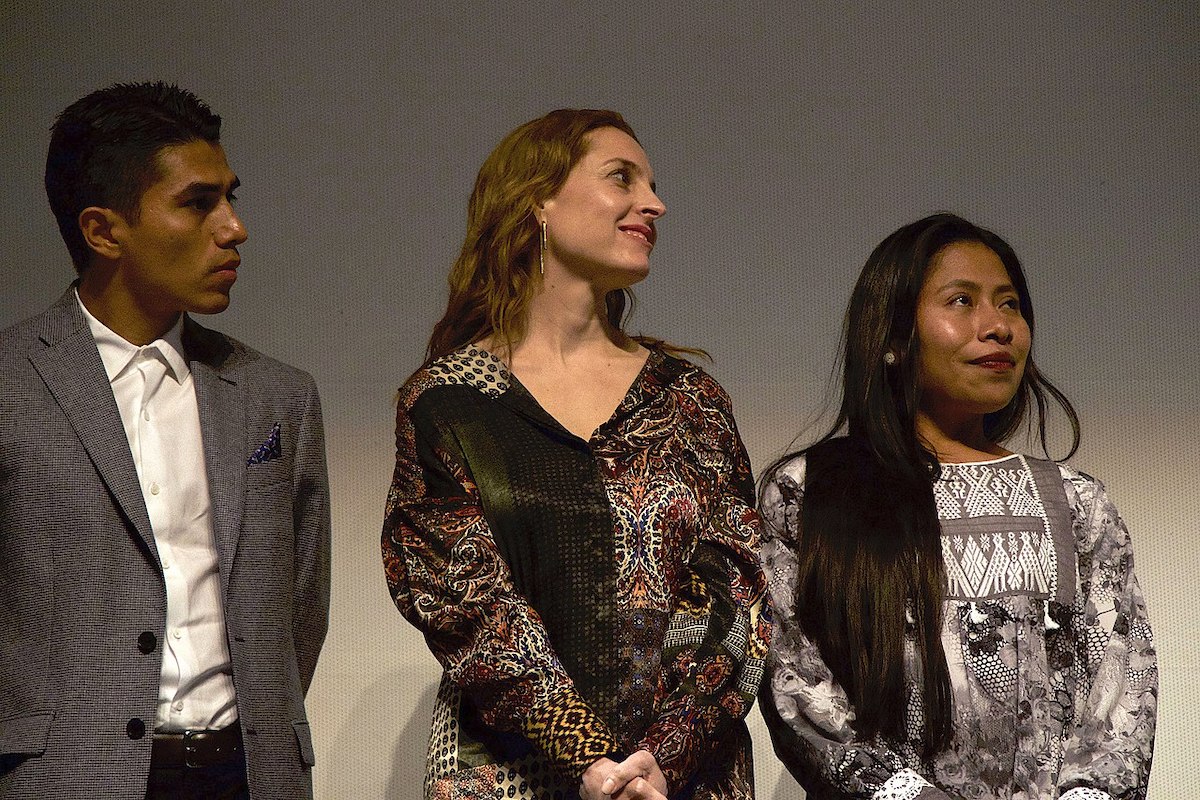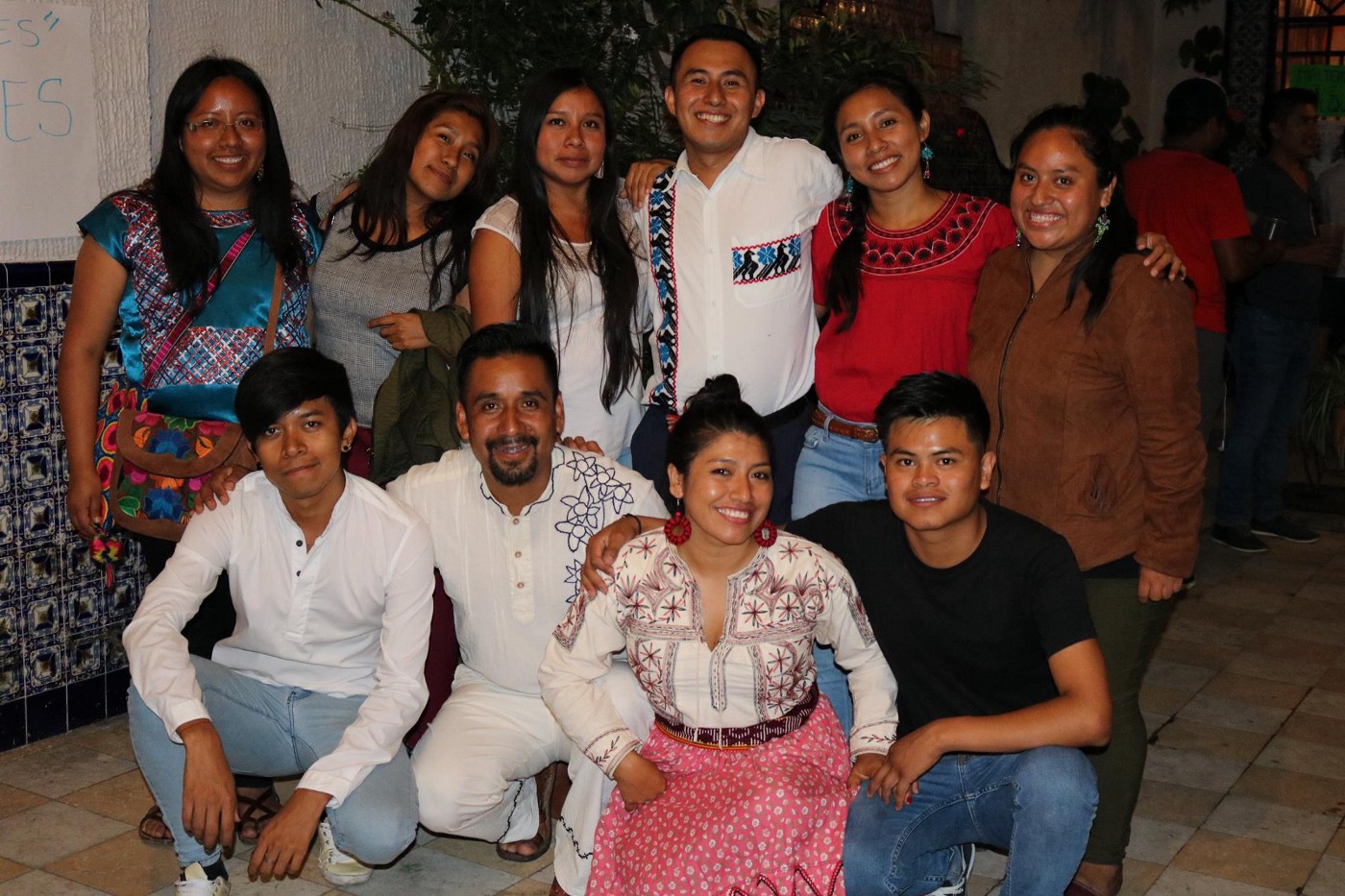

Yalitza Aparacio (right) during a 2018 screening of Roma in Mexico City. (Photo by Milton Martínez via Secretaría de Cultura de la Ciudad de México/CC BY 2.0)
“Así es, soy prieta, prietieta linda y con la frente en alto.” (That’s right, I am dark-skinned, a lovely dark-skinned woman with her head held high.) — Yalitza Aparicio
This past June, GQ Mexico hosted a virtual discussion on racism featuring acclaimed actors Yalitza Aparicio and Tenoch Huerta, and scholars Mónica Moreno Figueroa and Yásnaya Elena Aguilar—all people of color, within U.S. parlance. The discussion was held in the wake of the police murder of George Floyd in Minneapolis and the ensuing surge of global support for the Black Lives Matter movement, including in Mexico, where the brutal police murder of Giovanni López in Guadalajara spurred a week of protests. But this conversation also emerges at the conjuncture of rising debate within Mexico and amongst Latinxs in the United States regarding race and racism.
In recent weeks, social media platforms discussed the racist and classist TV Azteca variety show’s satire of artist Amandititita, while a clip of actress Bárbara de Regil went viral when she self-captured her disgust at the filter that darkened her complexion during her recorded cardio session, exclaiming “Ay qué prieta, no, qué feo!” (Oh no, I’m so dark, how ugly!”).
https://www.facebook.com/103638484435490/videos/301892550822805/
Twitter handle, Cosas de Whitexicans (“Things of White Mexicans”) has similarly exposed a range of racist content and pokes fun at the narcissistic lifestyles of upper class white Mexicans and social media influencers. Yalitza Aparicio’s own rise to fame as the protagonist of Alfonso Cuarón’s award-winning Roma lays bare the severely normalized acceptance of racist sentiments, including a recent round of criticism over the actress’s admission to the new cohort of the Academy of Motion Picture Arts and Sciences, as well as her invitation to write opinions for the New York Times.
It is long overdue that these realities be noted and discussed in order to be transformed, and I am hopeful that the emergence of these debates indicates that something remarkable is happening as a new generation of scholars, activists, journalists and artists create narratives for a new social praxis based on anti-racism and decolonization.
A few years back it would have been very difficult to find platforms through which to discuss race and racism in Mexico. When I began sharing my writing and research detailing the contemporary experiences of Indigenous youth as they confronted and challenged structural and everyday forms of discrimination, few people I encountered, beyond the Wixarika university students who collaborated and protagonized my research, seemed interested. Within Mexico, the fact of racism has often been downplayed by the country’s long tradition of centering the mestizo identity as one that is composed of various racial and ethnic lineages. European cultural mannerisms, political economic orders, language, and general world views were to replace or, at the least, hybridize with Indigenous heritages. Because of this history, how could a nation of people of Indigenous, European and African descent be racist?
Meanwhile, in the United States, to speak of race and racism in Mexico or amongst the Latinx population still connotes surprise for those unfamiliar with the engrained racial order established under colonialism in Latin America. Aren’t Mexicans a race of people unto themselves? Few people understand how ethnic, racial and class identities differ from country to country within Latin America and across the diverse Latinx demographic in the United States.
Just two years ago, I was invited to testify at an immigration hearing and make the argument that racism and racial violence do in fact exist in Mexico. I spoke to support the claims of a Wixarika Indigenous man who had faced explicit racial violence beginning in grade school and, later, at the hands of mestizo cattle ranchers and in the agricultural fields of Nayarit. He had lived in California for nearly 30 years and now faced family separation and deportation to a place that he had fled. The white judge appeared skeptical, suggesting whether the man could be “returned” instead to a state in southern Mexico like Oaxaca or Yucatán where there are is a larger Indigenous population and, perhaps, less racism. So goes the logic that feeds the geographies of deportation destinations.
The reality is that racism, and specifically anti-Black and anti-Indigenous attitudes and practices are a fact of life in the Yucatán Peninsula, Guadalajara, at the U.S.-Mexico border, and in various Latinx communities in the United States. More specifically, not only does white supremacy exist within the broadly categorized Latinx communities in the United States, it also exists across the Americas in various country-specific iterations. Over the years, researchers North and South have found that skin color, or what some have labeled pigmentocracy, determines a spectrum of institutional and interpersonal treatment, and thus, social mobility. Racism converges with acute forms of classism throughout the hemisphere, demonstrating that the gradients used to determine social standing during the colonial era remain deeply engrained, yet increasingly contested and disrupted.
Over the past few years, discussions on race, ethnicity and racism within many Latinx communities have become more frequent but are often mired in the difficulty of negotiating the highly regional yet entangled forms in which experiences of racialization and racism have taken shape. In my college courses, I try to bring to light the ways in which legacies of racialization and racial violence under the Spanish colonial system and legacies of British and U.S. racial capitalism continue to be the base of contemporary political power, yet are also at the heart of everyday struggles and resistances that have led to empowerment through decolonization. This can be observed in the widening activist networks of people of African descent as well as in the heterogeneous Indigenous leadership that has driven many of these debates, particularly amongst Indigenous women.


Members of the Jóvenes Indígenas Urbanos intertribal collective of Guadalajara. (Courtesy JIU, 2019)
Since 2007, I have researched and worked alongside a growing network of Wixarika university students and young professionals who have begun to break down significant barriers in higher education and across professions, from public health and education, to grassroots and state politics. At the same time, the celebration of Indigenous beauty has taken a new turn with Vogue Mexico now centering Indigenous models, including an issue featuring famed Raramuri distance runner, Lorena Ramírez. In 2019, 18 year-old María Melchor González, or Yukaima, won the state beauty pageant of Nayarit, wearing a Wixarika-inspired pageant dress. These varied gains have required a great deal of persistence and struggle, fomented by the unity and widening networks of Indigenous peoples across tribal and geographical boundaries.
As racial violence continues to ripple across our geographies, the voices of a revolution have arrived once more, hidden in plain sight. It is a revolution that is deeply intimate and public at once, based on generations of living and dying because of it, deeply inhabited by Black and Indigenous peoples across the Western Hemisphere. These voices, more than ever, are challenging racism and working to burry it.
***
Diana Negrín, Ph.D., is a geographer, writer, educator and curator based in Oakland and Guadalajara.



Don’t use Latinx; it is angelicized version to another language and people. As a Mexican American, and Spanish speaker, I find it offensive.